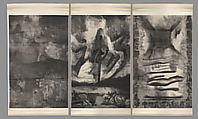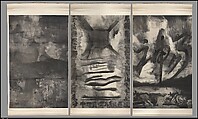Returned to lender The Met accepts temporary loans of art both for short-term exhibitions and for long-term display in its galleries.
Mythos of Lost Dynasties Series—Tranquility Comes from Meditation (Primitive World, Composition of Words, and Synthesized Words)
Gu Wenda Chinese
Not on view
A leading figure in the New Wave experimental art movement of the 1980s, Gu sought to liberate his painting and calligraphy from traditional technical and aesthetic strictures. Among his earliest works are these three scrolls, part of an original pentad that feature characters hovering over or within surreal “splashed ink” landscapes. The central scroll, with its single invented ideograph suspended over a landscape, established the pattern for most of Gu’s later works in the Mythos of Lost Dynasties series. The full ideograph is unreadable, but the three cursive-script components (易, 申, 示) may be interpreted as the character for “unobstructed” (chang畅 畅) and that for “spirit” (shen 神). While Gu’s overriding purpose may have been to subvert the semantic function of calligraphy, his creation of a “new” symbol embodying the notion of an unfettered spirit is a powerful emblem of his wish to escape cultural stereotypes.
Due to rights restrictions, this image cannot be enlarged, viewed at full screen, or downloaded.
This artwork is meant to be viewed from right to left. Scroll left to view more.






